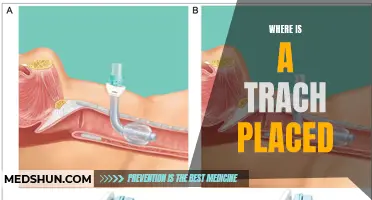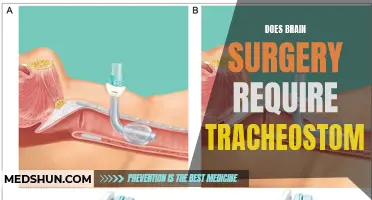
The suffix -stomy is derived from the Ancient Greek word stoma, meaning mouth or opening. When used in medical terminology, this suffix is added to indicate the creation of an artificial or surgical opening in a specific organ or structure. In the case of tracheostomy, the term refers to the procedure in which a surgical opening, or stoma, is made in the trachea (windpipe) to allow for an alternate airway. This introduction will explore the significance of the -stomy suffix in the context of tracheostomy and its impact on patient's breathing and quality of life.
| Characteristics | Values |
|---|---|
| Suffix | -stomy |
| Meaning | Creation of an opening or stoma |
| Origin | Greek |
| Examples | Gastrostomy, colostomy, ileostomy, urostomy |
| Surgical Procedure | Insertion of a tube or stoma into a hollow organ or body cavity |
What You'll Learn
- What is the specific meaning of the suffix -stomy in the term tracheostomy?
- How does the addition of the suffix -stomy change the meaning of the word tracheo?
- Can you provide other examples of medical terms that use the suffix -stomy?
- Is the suffix -stomy always used in relation to medical procedures?
- Are there any other suffixes that are commonly used in medical terms, and how do they differ from -stomy?

What is the specific meaning of the suffix -stomy in the term tracheostomy?
The suffix -stomy can be found in many medical terms and refers to a surgical opening or artificial opening of a structure. In the case of tracheostomy, it specifically refers to the creation of an opening into the trachea, or windpipe.
A tracheostomy is a surgical procedure that involves making an incision in the front of the neck and inserting a tube directly into the trachea. This is done to bypass any blockages in the upper airway and allow for easier breathing. The tube that is inserted is called a tracheostomy tube, and it can either be temporary or permanent, depending on the underlying condition.
The suffix -stomy comes from the Greek word "stoma," which means "mouth" or "opening." When combined with the prefix "tracheo-," which refers to the trachea, the term tracheostomy is formed. This surgical procedure is commonly performed in cases of severe respiratory distress, such as in patients with a compromised airway due to trauma, swelling, or an obstruction.
During a tracheostomy, the patient is typically under anesthesia, and a small incision is made in the lower portion of the neck, just above the breastbone. The trachea is then identified and a hole is created using a sharp instrument, such as a scalpel or a tracheostomy tube introducer. The tracheostomy tube is then inserted into the tracheal opening, and a securement device is used to hold it in place. Once the tube is in place, the incision is closed, and the patient is closely monitored for any complications.
The benefits of a tracheostomy include improved oxygenation, easier breathing, and the ability to remove secretions from the airway. It also allows for the delivery of certain medications directly into the trachea, bypassing the upper airway. However, there are also risks and potential complications associated with this procedure, such as infection, bleeding, damage to surrounding structures, and long-term complications such as tracheal stenosis.
In conclusion, the suffix -stomy in the term tracheostomy specifically refers to the creation of an artificial opening into the trachea. This surgical procedure is used to bypass blockages in the upper airway and improve breathing in individuals with severe respiratory distress. While there are risks and potential complications associated with a tracheostomy, it can provide important benefits for patients who cannot adequately breathe through their nose and mouth.
Eating with a Tracheostomy: Tips and Techniques for a Smooth Dining Experience
You may want to see also

How does the addition of the suffix -stomy change the meaning of the word tracheo?
When the suffix -stomy is added to the word tracheo, it changes the meaning of the word to refer to a surgical opening made in the trachea. Tracheo refers to the trachea, which is the windpipe, and -stomy means the creation of an artificial opening. Therefore, tracheostomy is the surgical procedure of creating a hole in the trachea to facilitate breathing.
Tracheostomy is typically performed when a person is unable to breathe naturally through their nose or mouth due to various reasons such as an injury, obstruction, or a medical condition like sleep apnea or paralysis. The procedure involves making a small incision in the front of the neck and carefully inserting a breathing tube, called a tracheostomy tube, into the opening.
Tracheostomies can be temporary or permanent depending on the patient's condition and needs. Temporary tracheostomies are often done in emergency situations, such as when a person's airway is blocked or when there is a need for long-term ventilation support after a surgery. Permanent tracheostomies, on the other hand, are done when a person requires ongoing assistance with breathing due to a chronic condition or when other methods of maintaining an airway have been unsuccessful.
The tracheostomy tube serves as an alternate pathway for airflow, bypassing the nose, mouth, and upper airway. It is connected to a ventilator or a bag-valve-mask device to deliver oxygen and assist with breathing. The tube also allows for easier removal of secretions and can help prevent lung infections.
While a tracheostomy can be life-saving and improve a person's quality of life, it does come with certain risks and considerations. Infections, bleeding, damage to surrounding structures, and difficulty speaking or swallowing are some potential complications. Proper care and maintenance of the tracheostomy tube, such as regular cleaning and suctioning, are essential to reduce the risk of complications.
In conclusion, the addition of the suffix -stomy to the word tracheo changes its meaning to refer to a surgical opening made in the trachea. Tracheostomy is a procedure performed to create a hole in the trachea to assist with breathing. It can be temporary or permanent depending on the patient's needs and can provide a vital lifeline for individuals with various respiratory conditions.
Understanding the Function of the Trachea: How Does It Contribute to Breathing?
You may want to see also

Can you provide other examples of medical terms that use the suffix -stomy?
The suffix -stomy is commonly used in medical terminology to refer to surgical procedures in which an opening is made in the body. This opening can be used for various purposes, such as drainage, feeding, or the formation of a new pathway. Here are a few examples of medical terms that use the suffix -stomy:
- Colostomy: This surgical procedure involves creating an opening in the abdominal wall and connecting the colon to the surface of the skin. This allows stool to bypass a diseased or damaged part of the colon and exit through the opening, into a pouch attached to the skin. Colostomies are often performed in cases of colorectal cancer, diverticulitis, or inflammatory bowel disease.
- Tracheostomy: In this procedure, a surgical incision is made in the front of the neck and into the windpipe (trachea). A tube is inserted through this opening to create an alternative airway. Tracheostomies are commonly performed in cases of severe airway obstruction or when a patient needs long-term mechanical ventilation.
- Gastrostomy: This procedure involves creating an opening in the stomach and connecting it to the surface of the abdomen. A feeding tube is inserted through this opening to provide nutrition and hydration directly into the stomach. Gastrostomies are often performed in patients who are unable to eat or drink normally due to conditions such as swallowing disorders, esophageal cancer, or neurological disorders.
- Nephrostomy: This procedure involves creating an opening in the skin and through the kidney to provide an external drainage route for urine. A thin tube (catheter) is inserted through the opening and into the kidney to allow urine to drain into a bag outside the body. Nephrostomies are commonly performed in cases of kidney stones, kidney blockages, or urinary tract infections.
- Ileostomy: This surgical procedure involves creating an opening in the abdominal wall and connecting the small intestine (ileum) to the surface of the skin. This allows waste products to bypass a diseased or damaged part of the intestine and exit through the opening, into a pouch attached to the skin. Ileostomies are often performed in cases of inflammatory bowel disease, colorectal cancer, or trauma to the small intestine.
These are just a few examples of medical terms that use the suffix -stomy. Each procedure has specific indications and considerations, and they are performed by skilled healthcare professionals. If you have any questions or concerns about these or any other surgical procedures, it is important to consult with a healthcare provider who can provide you with personalized information and guidance.
How Does Thyroid Split During Tracheostomy Affect Hypothyroidism?
You may want to see also

Is the suffix -stomy always used in relation to medical procedures?
The suffix -stomy is commonly used in medical terminology to describe a surgical procedure that creates an opening, or stoma, in the body. However, it is not exclusively used in relation to medical procedures. In some cases, the suffix -stomy can also be used in non-medical contexts to refer to other types of surgical or non-surgical interventions.
In medical terminology, the suffix -stomy is often used to describe procedures that involve creating an opening between a hollow organ and the skin surface. Examples of common medical procedures that use the -stomy suffix include colostomy, ileostomy, and tracheostomy.
A colostomy is a surgical procedure that creates an opening in the abdominal wall to allow stool to pass out of the body when the lower part of the large intestine (colon) is removed or cannot function properly. Similarly, an ileostomy is a surgical procedure that creates an opening in the abdominal wall to allow waste material to pass out of the body when the entire large intestine and part of the small intestine (ileum) are removed.
In the case of a tracheostomy, the -stomy suffix is used to describe the surgical procedure of creating an opening in the trachea (windpipe) to assist with breathing. This is usually done when a person is unable to breathe through their nose or mouth due to injury, illness, or surgical removal of the larynx.
While the suffix -stomy is most commonly used in medical procedures, it can also be used in non-medical contexts to describe surgical or non-surgical interventions that create an opening or connection. For example, in the field of agriculture, an arteriovenostomy refers to a surgical procedure that connects an artery to a vein. In certain manufacturing processes, the term ostomy may be used to refer to a process that involves creating an opening or perforation.
In conclusion, while the suffix -stomy is primarily used in relation to medical procedures that involve creating an opening in the body, it can also be used in non-medical contexts to describe surgical or non-surgical interventions that involve creating an opening or connection. The suffix -stomy is versatile and can be used in various fields to describe procedures that involve creating an opening or connection between different parts of the body or objects.
The Truth About Valerie Harper and Her Tracheostomy
You may want to see also

Are there any other suffixes that are commonly used in medical terms, and how do they differ from -stomy?
In the medical field, suffixes are commonly used to create new medical terms by modifying the root word. One of the common suffixes used in medical terminology is -stomy, which signifies the creation of a surgical opening in the body. However, there are several other suffixes that are commonly used in medical terms, each serving a different purpose.
One such suffix is -ectomy, which is used to denote the surgical removal of a specific body part or tissue. For example, a tonsillectomy is the surgical removal of the tonsils, while a hysterectomy is the removal of the uterus. The -ectomy suffix is useful in indicating the specific surgical procedure being performed.
Another commonly used suffix in medical terms is -itis, which signifies inflammation of a specific organ or tissue. For example, appendicitis is the inflammation of the appendix, while arthritis is the inflammation of the joints. The -itis suffix helps identify the inflammatory condition affecting a particular body part.
Similarly, the suffix -osis is used to denote a non-inflammatory disorder or a pathological condition. For instance, osteoporosis is a condition characterized by the loss of bone density, while cirrhosis is the scarring of the liver tissue. The -osis suffix helps identify the non-inflammatory nature of these disorders.
In contrast to -stomy, which indicates the creation of a surgical opening, suffixes like -ostomy and -otomy are used to denote the surgical procedure or the creation of an opening. For instance, a colostomy is the surgical creation of an opening in the colon, while a tracheotomy is the surgical procedure of creating an opening in the trachea. The -ostomy and -otomy suffixes help specify the type of surgical procedure being performed and the organ or tissue involved.
It is important to note that different suffixes in medical terms serve different purposes and provide specific information about the procedure or condition being described. Understanding these suffixes can help healthcare professionals and patients better interpret medical terminology and communicate effectively about medical procedures and conditions.
Overall, while -stomy is a common suffix used to denote the creation of a surgical opening, there are several other suffixes such as -ectomy, -itis, -osis, -ostomy, and -otomy that serve different purposes in medical terminology. Each suffix provides specific information about the surgical procedure or condition being described, allowing for clear and concise communication in the medical field.
The Increasing Number of Tracheostomies Performed Annually: A Growing Trend or Cause for Concern?
You may want to see also
Frequently asked questions
The suffix -stomy in the term tracheostomy refers to the creation of a new opening or artificial opening. In this case, a tracheostomy involves creating an opening in the trachea (windpipe) to allow for proper breathing.
The purpose of a tracheostomy is to provide an alternative airway for individuals who are unable to breathe properly through their nose or mouth. This can be due to various reasons such as an obstruction in the upper airway or a respiratory condition that causes difficulty in breathing.
Some potential complications of a tracheostomy include infection at the site of the opening, bleeding, difficulty speaking or swallowing, damage to the trachea or surrounding structures, and blockage or obstruction of the tube that is inserted into the trachea. These complications can be minimized and managed with proper care, monitoring, and regular cleaning of the tracheostomy site and equipment.







